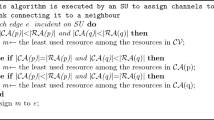Abstract
The inherent nature of cognitive radio (CR) networks has brought new threats to wireless communications. Primary user emulation attack (PUEA) has been widely studied as a serious threat to cooperative spectrum sensing (CSS) in CR networks. In PUEA, a malicious user can obstruct CR users from accessing idle frequency bands by imitating licensed primary user (PU) signal characteristics. The present study introduces a new CSS scheme in the presence of a malicious PUEA based on multi-level hypothesis testing (MLHT). In the proposed method, generalizing from binary hypothesis testing to MLHT, we partition the decision space to four decision options and apply minimum Bayes cost criteria to determine the channel status. We also discuss practical limitation issues that need to be considered when applying the MLHT approach. Simulation results are provided to indicate the performance improvement of the proposed MLHT method against PUEA, compared with the conventional method.








Similar content being viewed by others
References
Federal Communications Commission. (2002). Spectrum policy task force report. ET Docket No; 02-135.
Haykin, S. (2006). Cognitive radio: Brain-empowered wireless communications. IEEE Journal on Selected Areas in Communications, 23(2), 201–220.
Mitola, J., & Maguire, G. Q. (1999). Cognitive radio: making software radios more personal. IEEE Personal Communication, 6(4), 13–18.
Cabric, D., Mishra, S., & Brodersen, R. (2004). Implementation issues in spectrum sensing for cognitive radios. In IEEE Asilomar conference on signals, systems, and computers (pp.772–776).
Akyildiz, I. F., Lee, W. Y., Vuran, M. C., & Mohanty, S. (2006). NeXt generation/dynamic spectrum access cognitive radio wireless networks: A survey. Computer Networks, 50(13), 2127–2159.
Mishra, S. M., Sahai, A., & Brodersen, R. W. (2006). Cooperative sensing among cognitive radios. In Proceedings of the IEEE international conference on communications (pp. 1658–1663).
Ghasemi, A., & Sousa, E. S. (2007). Opportunistic spectrum access in fading channels through collaborative sensing. Journal of Communications, 2(2), 71–82.
Ma, J., Zhao, G., & Li, Y. (2008). Soft combination and detection for cooperative spectrum sensing in cognitive radio networks. IEEE Transactions on Wireless Communications, 7(11), 4502–4507.
Chen, R., & Park, J. M. (2006). Ensuring trustworthy spectrum sensing in cognitive radio networks. In 1st IEEE workshop on networking technologies for software defined radio networks (pp. 110–119).
Chen, R., Park, J. M., & Reed, J. H. (2008). Defense against primary user emulation attacks in cognitive radio networks. IEEE Journal of Selected Area in Communications, 26(1), 25–37.
Leon, O., Hernandez-Serrano, J., & Soriano, M. (2012). Cooperative detection of primary user emulation attacks in CRNs. Computer Networks, 56(14), 3374–3384.
Ureten, O., & Serinken, N. (2007). Wireless Security through RF fingerprinting. Canadian Journal of Electrical and Computer Engineering, 32(1), 27–33.
Zhao, C., Wang, W., Huang, L., & Yao, Y. (2009). Anti-PUE attack base on the transmitter fingerprint identification in cognitive radio. In 5th international conference on wireless communications, networking and mobile computing (WiCom‘09) (pp. 1–5).
Anand, S., Jin, Z., & Subbalakshmi, K. (2008). An analytical model for primary user emulation attacks in cognitive radio networks. In Proceeding IEEE international dynamic spectrum access networks (pp. 1–6).
Jin, Z., Anand, S., & Subbalakshmi, K. (2009). Mitigating primary user emulation attacks in dynamic spectrum access networks using hypothesis testing. ACM SIGMOBILE Mobile Computing and Communication Review, 13, 74–85.
Jin, Z., & Subbalakshmi, K. (2009). Detecting primary user emulation attacks in dynamic spectrum access networks. In IEEE international conference on communications (pp. 1–5).
Xin, C., & Song, M. (2014). Detection of PUE attacks in cognitive radio networks based on signal activity pattern. IEEE Transactions on Mobile Computing, 13(5), 1022–1034.
Alahmadi, A., Abdelhakim, M., Ren, J., & Li, T. (2014). Defense against primary user emulation attacks in cognitive radio networks using advanced encryption standard. IEEE Transactions on Information Forensics and Security, 9(5), 772–781.
Chen, C., Cheng, H., & Yao, Y.-D. (2011). Cooperative spectrum sensing in cognitive radio networks in the presence of the primary user emulation attack. IEEE Transactions on Wireless Communications, 10(7), 2135–2141.
Haghighat, M., & Sadough, S. M. S. (2014). Cooperative spectrum sensing for cognitive radio networks in the presence of smart malicious users. International Journal of Electronics and Communications (AUE), 68(6), 520–527.
Haghighat, M., & Sadough, S. M. S. (2014). Smart primary user emulation in cognitive radio networks: Defense strategies against radio-aware attacks and robust spectrum sensing. Transactions on Emerging Telecommunications Technologies, 26, 1154–1164.
Saber, M. J., & Sadough, S. M. S. (2015). Optimal soft combination for multiple antenna energy detection under primary user emulation attacks. International Journal of Electronics and Communications (AEU), 69(9), 1181–1188.
Varshney, P. K. (1997). Distributed detection and data fusion. Berlin: Springer.
Levy, B. C. (2008). Principles of signal detection and parameter estimation. Berlin: Springer.
Author information
Authors and Affiliations
Corresponding author
Rights and permissions
About this article
Cite this article
Sharifi, M., Sharifi, A.A. & Niya, M.J.M. Cooperative spectrum sensing in the presence of primary user emulation attack in cognitive radio network: multi-level hypotheses test approach. Wireless Netw 24, 61–68 (2018). https://doi.org/10.1007/s11276-016-1321-0
Published:
Issue Date:
DOI: https://doi.org/10.1007/s11276-016-1321-0




